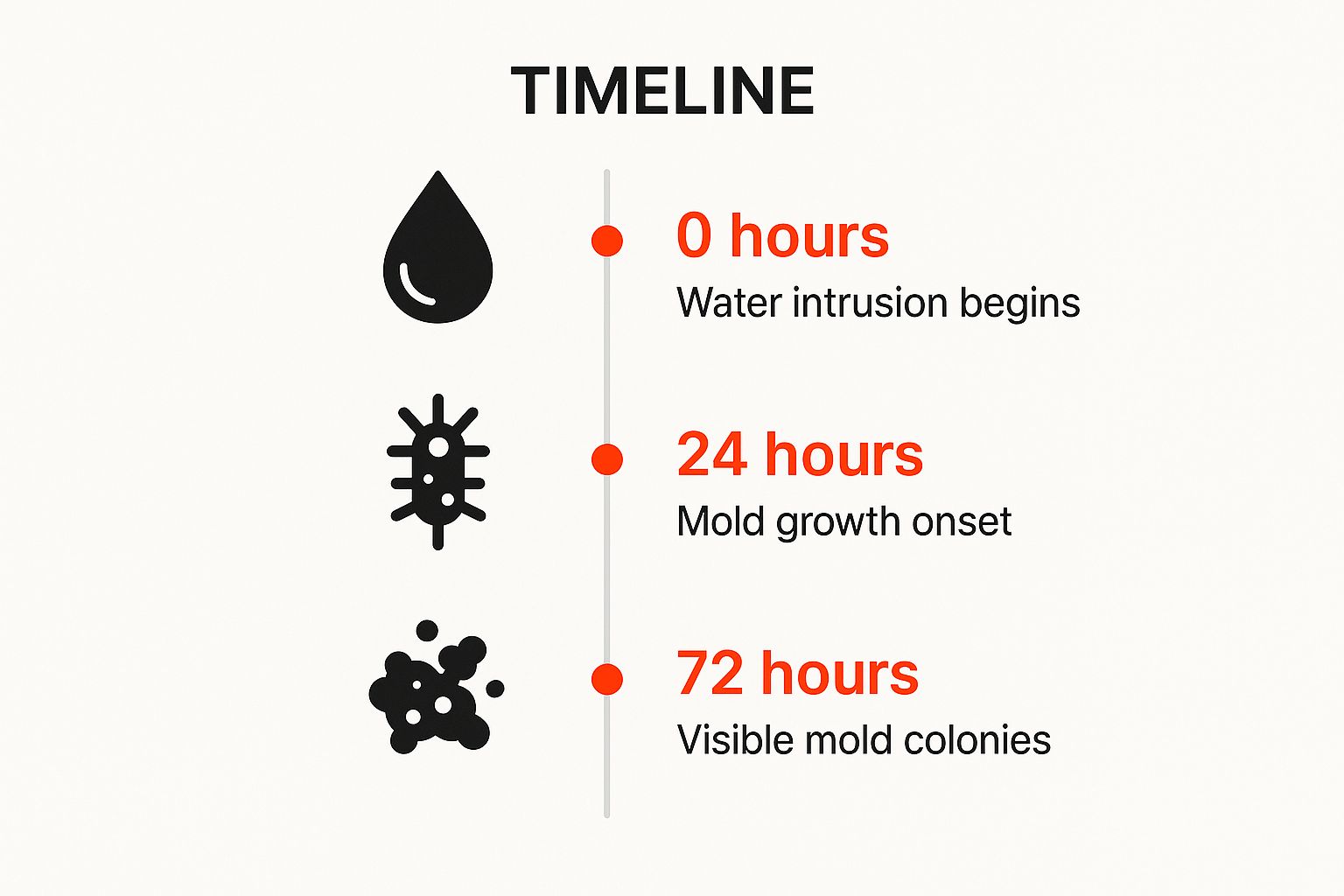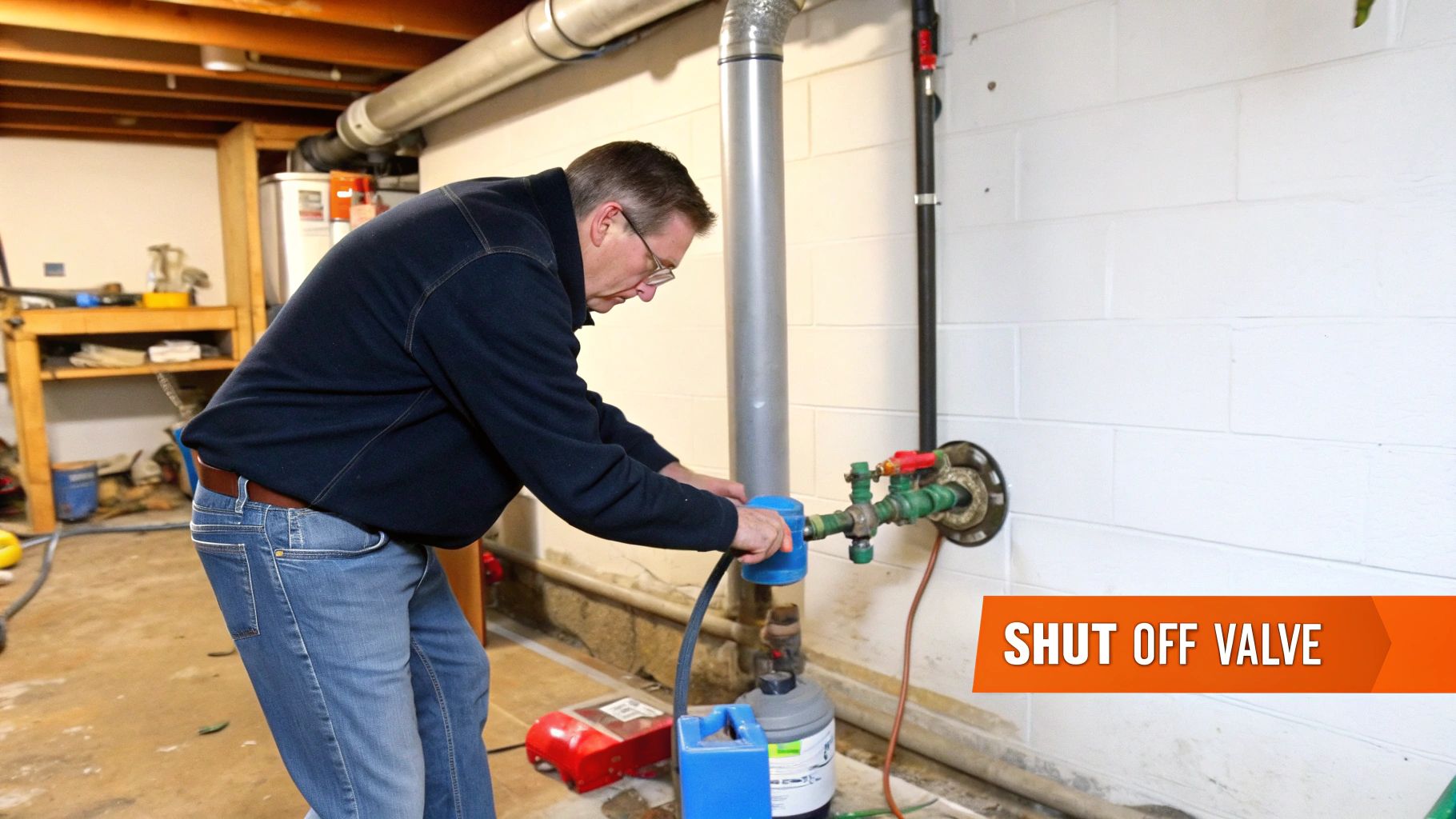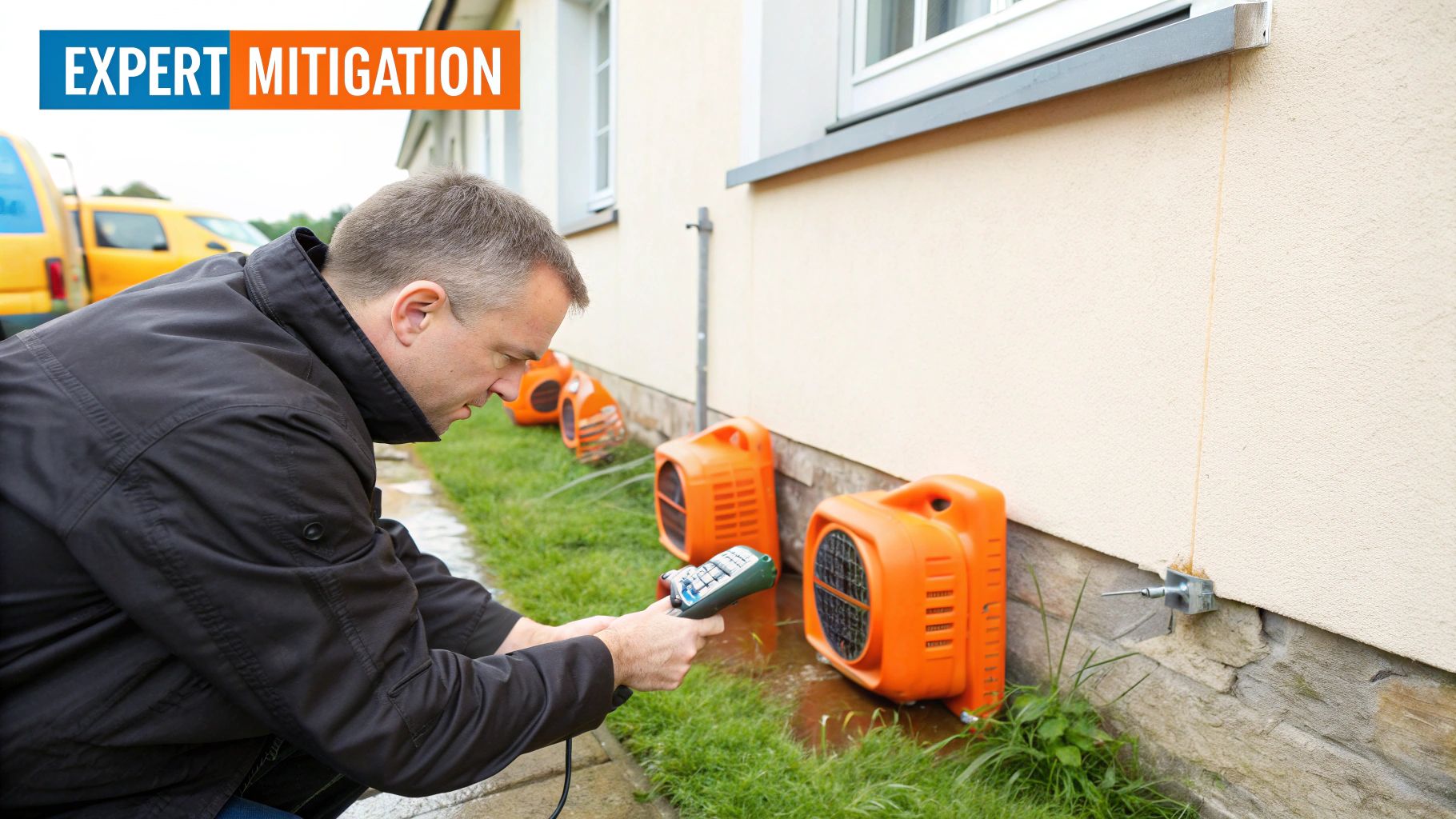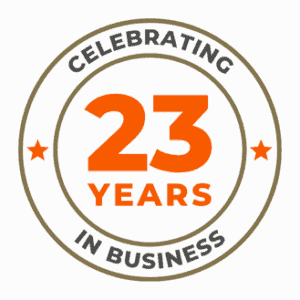When your Orange County home is faced with water damage, water and mold mitigation becomes a race against the clock. What begins as unseen moisture from a leaky pipe can explode into a visible—and hazardous—mold problem faster than most homeowners realize. Once water intrudes, mold spores, which are always present in the air, can colonize damp drywall, carpet, and wood in as little as 24 to 48 hours. This is why a swift, decisive response from a trusted expert is non-negotiable for protecting your property and family.
The Unseen Link Between Water Damage and Mold
That tiny, persistent drip under your kitchen sink or the slow leak from an appliance hose isn’t just a minor annoyance. For discerning homeowners in communities like Newport Beach and Irvine, it’s the start of a critical countdown. The connection between water damage and mold is direct and shockingly fast, turning a simple moisture issue into a major indoor air quality hazard and a threat to your home’s structural integrity.
Mold spores are everywhere, waiting for the right conditions to spring to life. All they need is moisture and a food source—like the paper on drywall, wood framing, or carpet fibers. When a water event occurs, it’s like flipping a switch.
The science is clear: this isn’t a slow process. Within the first 24 hours, activated spores begin to germinate, sending out microscopic roots that dig into damp materials. By the 48-hour mark, these colonies are established and multiplying, often long before you see any visible signs.
The Critical 72-Hour Window
Consider a scenario we at Sparkle Restoration Services encounter frequently: a dishwasher supply line starts a slow, hidden leak. For days, water quietly seeps into the subfloor and the drywall behind the unit. There’s no standing water to see, but perhaps a faint, musty odor emerges. By the time the dishwasher is pulled out, mold is already climbing up the wall. This is precisely why understanding this timeline is the first step in effective water and mold mitigation.
The table below breaks down just how quickly a water issue can escalate into a full-blown mold crisis. It’s a sobering look at why every hour counts.
Water Damage to Mold Growth Timeline
| Timeframe | What’s Happening | Recommended Action |
|---|---|---|
| First 24 Hours | Water soaks into materials like drywall, wood, and insulation. Spores begin to activate and germinate. | Immediate water extraction and drying. This is the critical window to prevent mold growth entirely. |
| 24-48 Hours | Mold colonies begin to form, though they may not be visible to the naked eye yet. A musty odor often develops. | Aggressive drying and dehumidification. Professional assessment is needed to check for hidden moisture. |
| 48-72 Hours | Visible mold spots may appear on surfaces. The colonies are established and spreading rapidly. | Mold remediation is now required. The area must be contained by certified professionals to prevent cross-contamination. |
| 1 Week & Beyond | Significant mold growth is present. Structural materials may be compromised. Indoor air quality is poor. | Extensive remediation and potential structural repairs. Professional intervention is essential for safety and property preservation. |
As this timeline shows, the window for simple water removal closes fast. After just two days, you’re no longer just dealing with water—you’re facing a mold problem that requires specialized expertise.

This visual drives the point home: what starts as a water problem quickly becomes a complex mold remediation project if you don’t act immediately.
As an IICRC Master Certified firm and a Licensed General Contractor, we’ve seen this exact scenario play out countless times. Procrastination is mold’s best friend. Your most powerful defense is taking immediate, decisive action with a qualified team.
The Growing Need for Professional Restoration
This rapid growth cycle is precisely why professional intervention is so crucial. The damage restoration industry, which includes specialized services for water and mold mitigation, is growing because more property owners understand these risks. Valued at USD 13.8 billion in 2024, the market is projected to hit USD 22.6 billion by 2033. This statistic reflects a growing awareness that you need experts to handle moisture properly to prevent long-term structural damage and health problems.
Hoping an area will “dry on its own” is a gamble you’re almost guaranteed to lose. Without professional drying equipment and techniques, lingering moisture becomes a welcome mat for mold. To dive deeper, explore our detailed guide on what happens when water damages your home.
Our mission at Sparkle Restoration Services is to empower you with the knowledge to act with confidence. By understanding the urgency, you can stop a potential disaster before mold takes over your home.
Spotting the Hidden Signs of Moisture and Mold

Mold rarely announces its arrival. Long before you see a dark spot on the wall, your home sends out subtle clues that something isn’t right. Learning to recognize these early warning signs is key to effective water and mold mitigation and can save you from significant stress and expense. Our best advice? Trust your senses. What you smell, see, and feel can often uncover a problem hiding just out of sight.
The first and most common giveaway is that unmistakable musty odor. It’s an earthy, damp smell caused by microbial volatile organic compounds (MVOCs) released by active mold. If you catch a whiff of this, especially in a concentrated area like a laundry room, under a sink, or in a poorly ventilated bathroom, it’s a major red flag that mold is growing nearby—even if it’s behind a wall or beneath flooring.
Look Beyond the Obvious Visual Cues
While your nose is a powerful detection tool, your eyes can spot trouble too, provided you know what to look for. Visible mold colonies are actually the final stage of the problem. The initial signs of water intrusion are far more subtle.
Keep a close eye on the surfaces in your home; they are often the first to show proof of a moisture issue.
- Peeling, Bubbling, or Cracking Paint: When drywall gets wet, the moisture pushes the paint off the surface. This is a classic indicator of a hidden leak.
- Discoloration and Stains: Don’t dismiss faint yellowish or brownish stains on ceilings and walls. Even if they feel dry, they are the calling card of a slow, intermittent leak.
- Warped Materials: Wood and composite materials swell as they absorb moisture. Look for warped baseboards, buckled hardwood floors, or cabinet doors that suddenly don’t close properly.
Think of these signs as your home’s cry for help. Catching them early can be the difference between a small, targeted repair and an extensive remediation and remodeling project.
Feel for Changes in Your Home
Sometimes the most definitive proof comes from what you can feel. When investigating a suspicious area, pay attention to the touch. A wall that feels oddly cool, damp, or even soft is a dead giveaway that the drywall behind it is saturated. That “spongy” feeling means its structural integrity is already compromised.
The same goes for your floors. If an area feels soft or springy underfoot, it could mean the subfloor is water-damaged and possibly deteriorating. These tactile clues are clear signs that it’s time to call in an expert.
As a BBB Torch Award Winner for Ethics, we believe in empowering our clients. A careful inspection using your own senses is a powerful first step. If your intuition tells you something is off with a particular room or wall, it’s almost always right.
The Professional’s Eye: Advanced Detection Tools
While your senses are your first line of defense, we professionals in Orange County use advanced technology to confirm suspicions and pinpoint the moisture source without destructive testing. At Sparkle Restoration Services, we rely on tools like thermal imaging cameras and moisture meters to see what the naked eye can’t.
A thermal imaging camera reveals temperature differences across surfaces. Since wet areas are cooler, they appear as distinct cold spots on the camera, instantly showing the extent of water intrusion. A moisture meter then gives us a precise reading of the moisture content inside materials like drywall or wood, confirming exactly where the problem lies.
This technology allows for a targeted, non-invasive approach to water and mold mitigation, ensuring we solve the entire problem, not just the visible part. Many homeowners are surprised by the different types of mold; you can debunk common misconceptions by exploring our guide on the facts and myths about mold remediation. By combining your observations with our expert assessment, we turn chaos into calm, fast.
Your First Moves After Discovering Water Damage

The moment you find water pooling on the floor or a dark stain spreading across your ceiling can feel chaotic. However, what you do in these first few minutes is absolutely critical. A calm, methodical response can significantly reduce the final damage, paving the way for a smoother recovery.
Your immediate goal is simple: stop the problem from getting worse while you get professional help on the way.
The absolute first priority is safety. If you see significant standing water, particularly near electrical outlets or appliances, do not hesitate. Go to your circuit breaker and cut the power to the affected rooms. Water and electricity are a deadly combination, and protecting your family is paramount.
Next, stop the water at its source. For a burst pipe or a leaking appliance, find your home’s main water shutoff valve and turn it off. This single action can prevent thousands of gallons of water from causing catastrophic damage.
Document Everything Meticulously
Once the immediate threats are under control, shift your focus to documentation. Before moving anything, pull out your smartphone and start recording.
- Take Videos: Walk through every affected area, describing what you see. Capture any standing water, drips from the ceiling, and damaged personal items.
- Take Photos: Get wide shots of each room to establish the overall scene, then zoom in for close-ups of specific damage—soaked carpets, warped baseboards, and waterlogged furniture.
- Don’t Throw Anything Away: It’s tempting to start clearing out ruined items, but hold off. Keep everything until your insurance adjuster has inspected it. Disposing of items prematurely can complicate your claim.
This visual evidence is invaluable for your insurance claim, creating a clear “before” picture that proves the initial scope of the damage.
Common Mistakes to Avoid
In the panic to “fix” things, many well-meaning property owners make mistakes that worsen the situation. Knowing what not to do is as important as knowing what to do.
Never use a regular household fan to dry a soaked area. While seemingly logical, these fans can aerosolize existing mold spores and spread them throughout your home, turning a contained issue into a widespread contamination problem.
Also, resist the urge to rip up soaked carpeting or tear out wet drywall yourself. These materials become incredibly heavy when saturated, and handling them without proper personal protective equipment (PPE) can expose you to contaminants. Professional water and mold mitigation relies on specific containment protocols to prevent this exact type of cross-contamination.
Finally, do not use a household vacuum cleaner to remove water. It is not designed for this purpose and can cause an electric shock or destroy the machine.
Make the Most Important Call
After securing the area and documenting the damage, the most crucial step is to call for professional help. You need a 24/7 emergency restoration service because, as we’ve established, the clock on mold growth starts immediately.
An IICRC-certified team has the specialized equipment—like industrial-grade air movers and dehumidifiers—essential for properly drying your home’s structure and stopping mold in its tracks. For Orange County homeowners, this immediate professional response is what turns chaos back into calm.
Being prepared is always a smart move. Consider assembling a Water Emergency First Aid Kit with key tools and contact info before a disaster strikes. Acting fast and calling in experts ensures the water and mold mitigation process begins correctly from the very start.
A Look Inside Professional Mitigation and Remediation

When our Sparkle Restoration Services team arrives at your Orange County property, our first job is to turn chaos into calm. The process of professional water and mold mitigation is a scientific, multi-stage operation designed to be thorough, safe, and effective. It goes far beyond mopping up; it’s about meticulously restoring your home to its healthy, pre-damage condition with an expert touch.
Everything we do is guided by the rigorous standards of the Institute of Inspection, Cleaning and Restoration Certification (IICRC). This framework ensures every action is based on proven industry science. We’re not just cleaning up; we’re protecting your property’s value and your family’s health.
Comprehensive Damage Assessment
The first phase is a meticulous assessment. We don’t just look at the puddle—we trace water’s entire path. Our certified technicians use advanced diagnostic tools to map the full extent of moisture, both seen and unseen.
- Moisture Meters: These allow us to get precise moisture readings from deep inside materials like drywall, wood framing, and subflooring.
- Infrared (Thermal) Cameras: This is our secret weapon. Thermal imaging instantly shows temperature differences, highlighting cooler, damp areas that are invisible to the naked eye.
- Hygrometers: We measure the humidity and temperature in the affected space to establish a scientific baseline for our drying strategy.
This detailed, data-driven approach is what separates a professional, IICRC-certified firm from a general handyman. We find every pocket of moisture, leaving nothing to chance.
Water Extraction and Structural Drying
With a complete picture, water removal begins immediately. Using powerful, truck-mounted extraction equipment, we can remove hundreds or even thousands of gallons of standing water from your property quickly.
After the standing water is gone, we shift to the most critical phase: structural drying. This is where professional-grade equipment truly shines. We strategically deploy specialized tools to create the perfect drying environment.
- Industrial-Grade Air Movers: These high-velocity fans are positioned to create a powerful vortex of airflow across wet surfaces, dramatically speeding up evaporation.
- Low-Grain Refrigerant (LGR) Dehumidifiers: These are the real workhorses. They pull incredible amounts of moisture directly from the air, which is essential for drying the actual structure of your home.
A common misconception is that a few box fans can do the job. In reality, they just blow humid air around. Our professional equipment actively strips water vapor from the environment—the only way to properly dry the structure and prevent mold.
Meticulous Mold Remediation and Sanitization
If mold has already started to grow, the project transitions into a tightly controlled remediation process. The safety of your family and our team is paramount, so we establish strict containment protocols first. This often involves using negative air pressure machines and heavy plastic sheeting to completely isolate the work area, preventing spores from contaminating the rest of your home.
Our technicians, in full personal protective equipment (PPE), will then carefully remove all mold-infested materials that cannot be salvaged, like drywall and insulation. Salvageable surfaces are treated with EPA-registered antimicrobial agents, followed by a thorough HEPA vacuuming to capture any remaining microscopic spores.
Technology has become a game-changer in this field. Tools like infrared cameras and advanced air quality sensors allow specialists to pinpoint mold with incredible accuracy. As of 2023, the mold and moisture assessment industry was valued at over $2.1 billion, showing the shift toward tech-driven precision. Want to learn more? Check out these future trends in mold remediation technologies.
By sharing our process, we hope to demystify what happens when you trust a BBB Torch Award Winner like Sparkle Restoration Services with your property. Our commitment is to manage every project with the highest level of expertise, as you can see in our water damage restoration work in Irvine, CA.
Proactive Strategies to Prevent Future Mold Issues
Once you’ve experienced professional water and mold mitigation, the last thing you want is a repeat performance. The best strategy is to shift from reacting to problems to actively preventing them. Keeping water out is the single most effective way to protect your home’s structure, value, and the health of everyone inside.
We see ourselves as your long-term partner in property care, empowering you with practical knowledge to defend your home. This is about a targeted approach that makes sense for Southern California homeowners who value quality and prevention.
Your Essential Home Maintenance Checklist
Routine inspections of key areas can catch small issues before they become expensive disasters. Making these checks a regular habit will keep you miles ahead of potential leaks.
Here are the critical spots to monitor:
- Appliance Hoses and Connections: Washing machines, dishwashers, and refrigerators with ice makers are common culprits. Inspect their braided steel hoses for any signs of bulging, cracking, or corrosion at connection points. A failed hose can release a shocking amount of water in minutes.
- Window and Door Seals: The Southern California sun is brutal on seals. Check the caulking and weatherstripping around all windows and doors before the rainy season. These seals are your first line of defense against storm-driven water intrusion.
- Roof and Attic Inspection: From a safe vantage point, look for missing, cracked, or damaged shingles. Inside the attic, ensure vents are clear of obstructions. Proper ventilation is essential for preventing the humid, stagnant air that mold thrives in.
Managing Exterior Water Flow
How water moves around your home’s exterior is just as critical as what happens inside. The goal is simple: ensure all water is directed away from your foundation.
Check the soil grade against your foundation; it should clearly slope downward, away from the house. Also, keep your gutters and downspouts clear of debris so they can effectively channel rainwater away from your home’s base during a downpour.
Preventing water intrusion is everything. Understanding potential expenses like drainage tile installation costs can help you budget for effective outdoor water management. Think of this proactive investment as a powerful tool in your prevention arsenal.
As a company that has seen the devastating effects of foundation leaks, we cannot stress this enough: controlling water outside your home is one of the most effective long-term strategies for keeping the inside dry and mold-free.
The Growing Importance of Prevention
Taking these preventative steps is more than just good homeownership; it’s a smart financial decision. The global mold remediation service market was valued at USD 1,234.6 million in 2023 and is projected to hit USD 1,516.8 million by 2030. A major driver for this growth is our aging infrastructure combined with an increase in severe weather events, highlighting the value of being proactive.
A little vigilance goes a long way. By putting these strategies into practice, you’re not just performing maintenance; you’re actively investing in your property’s longevity and your family’s well-being. If you’re unsure where your home’s weak spots might be, our guide on how to ensure your home is leak-proof provides more detailed tips to help you secure your property.
Frequently Asked Questions About Water and Mold Mitigation
When you’re facing a water or mold problem, it’s natural to have questions. As Orange County’s trusted restoration experts, we’re here to provide clear, authoritative answers so you can make confident decisions, even when things feel chaotic.
Here are some of the most common questions we receive about water and mold mitigation. We believe in turning chaos into calm—and doing it fast.
Is All Mold Dangerous to My Health?
This is a primary concern for every property owner. While not every mold species is “toxic,” any type of mold growing inside your home is a threat to your health and indoor air quality.
Many common indoor molds are allergens that can trigger respiratory issues, especially for children, people over 70 years old, or anyone with asthma or a compromised immune system. The infamous “black mold,” Stachybotrys chartarum, gets a lot of attention, but many other types can cause health problems. The bottom line: treat all indoor mold as a potential risk and have it addressed by certified professionals. Our goal isn’t just to identify the species; it’s to safely remove the contamination from your home for good.
Can I Just Clean Up the Mold Myself?
It’s tempting to grab some bleach and a sponge, especially for what looks like a small spot. For a tiny patch—less than 10 square feet—on a hard, non-porous surface like tile, a DIY approach might seem feasible. However, it’s a risky move.
Scrubbing visible mold can launch millions of spores into the air, spreading the problem to other parts of your house. More importantly, if that mold is on a porous material like drywall, wood, or carpet, what you see is merely the tip of the iceberg. The root system is deep inside the material.
Professional water and mold mitigation is about more than just cleaning. It’s about total containment and removing the source. We use specialized equipment like negative air machines and HEPA vacuums to stop cross-contamination—something household tools simply cannot do.
Will My Homeowners Insurance Cover This?
This is a critical question. Most standard homeowners policies cover water damage from a “sudden and accidental” event, like a burst pipe. Where it gets tricky is with the resulting mold. Mold coverage is often limited or may require a special endorsement on your policy.
Crucially, insurance almost never covers damage from a slow, long-term leak that is considered a maintenance issue. This is why you must act fast and document everything. As a trusted partner to our clients, we work with all major insurance carriers. We provide the detailed reports and photographic evidence required to help you navigate the claims process and maximize the coverage you deserve.
How Long Does the Mitigation Process Take?
Every situation is unique, so there is no single answer. The timeline for professional water and mold mitigation depends on several key factors:
- The extent of the water damage: A localized leak is a much quicker fix than a flooded basement.
- The materials affected: Drying dense materials like concrete or hardwood takes significantly longer than drying drywall.
- The amount of mold growth: Widespread contamination requires more intensive containment, cleaning, and removal steps.
Generally, the initial water extraction and equipment setup occur within the first day. The structural drying phase often takes three to five days. If we are also dealing with significant mold, the entire project, including any necessary repairs or remodeling, might extend to a week or more. We will always provide a clear, transparent timeline from the start so you know exactly what to expect.
At Sparkle Restoration Services, we understand that you need more than technical skill—you need a trustworthy partner to guide you through this stressful time. If you have more questions or require immediate 24/7 emergency service in Orange County, please do not wait. Schedule a free consultation with our IICRC Master Certified experts today and let us turn your chaos into calm, fast.

